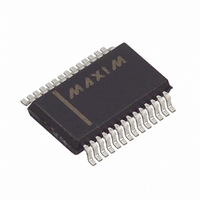MAX1901EAI+ Maxim Integrated Products, MAX1901EAI+ Datasheet - Page 24

MAX1901EAI+
Manufacturer Part Number
MAX1901EAI+
Description
IC CNTRLR PWR SPLY LN 28-SSOP
Manufacturer
Maxim Integrated Products
Datasheet
1.MAX1904ETJ.pdf
(33 pages)
Specifications of MAX1901EAI+
Applications
Controller, Notebook Computers
Voltage - Input
4.2 ~ 30 V
Number Of Outputs
4
Voltage - Output
2.5 ~ 5 V
Operating Temperature
0°C ~ 85°C
Mounting Type
Surface Mount
Package / Case
28-SSOP
Output Voltage
3.3 V, 5 V, 2.5 V to 5.5 V
Output Current
5 A
Input Voltage
4.2 V to 30 V
Mounting Style
SMD/SMT
Maximum Operating Temperature
+ 85 C
Minimum Operating Temperature
- 40 C
Lead Free Status / RoHS Status
Lead free / RoHS Compliant
Use a Schottky diode with a DC current rating equal to
one third of the load current. The Schottky diode’s rated
reverse breakdown voltage must be at least equal to
the maximum input voltage, preferably with a 20% der-
ating factor.
A signal diode such as a 1N4148 works well in most
applications. If the input voltage can go below +6V, use
a small (20mA) Schottky diode for slightly improved
efficiency and dropout characteristics. Don’t use large
power diodes, such as 1N5817 or 1N4001, since high
junction capacitance can pump up V
voltages.
The secondary diode in coupled-inductor applications
must withstand flyback voltages greater than 60V,
which usually rules out most Schottky rectifiers.
Common silicon rectifiers, such as the 1N4001, are also
prohibited because they are too slow. This often makes
fast silicon rectifiers such as the MURS120 the only
choice. The flyback voltage across the rectifier is relat-
ed to the V
former turns ratio:
where: N = the transformer turns ratio SEC/PRI
Subtract the main output voltage (V
BACK
returned to V
breakdown rating must also accommodate any ringing
due to leakage inductance. The rectifier diode’s current
rating should be at least twice the DC load current on
the secondary output.
Low input voltages and low input-output differential volt-
ages each require extra care in their design. Low
absolute input voltages can cause the V
to enter dropout and eventually shut itself off. Low input
voltages relative to the output (low V
can cause bad load regulation in multi-output flyback
applications (see the design equations in the Transformer
Design section). Also, low V
also cause the output voltage to sag when the load cur-
rent changes abruptly. The amplitude of the sag is a
function of inductor value and maximum duty factor (an
500kHz Multi-Output, Low-Noise Power-Supply
Controllers for Notebook Computers
24
______________________________________________________________________________________
Rectifier Diode (Transformer Secondary Diode)
in this equation if the secondary winding is
V
V
OUT
SEC
V
FLYBACK
IN
OUT
= the primary (main) output voltage
- V
= the maximum secondary DC output
voltage
OUT
and not to ground. The diode reverse-
= V
difference, according to the trans-
SEC
+ (V
IN
Low-Voltage Operation
- V
IN
Boost-Supply Diode
OUT
- V
IN
OUT
- V
OUT
L
differentials can
L
OUT
linear regulator
)
to excessive
) from V
✕
N
differential)
FLY-
Electrical Characteristics parameter, 97% guaranteed
over temperature at f = 333kHz), as follows:
The cure for low-voltage sag is to increase the output
capacitor’s value. Take a 333kHz/6A application circuit
as an example, at V
f = 333kHz, I
tance of 470µF keeps the sag less than 200mV. The
capacitance is higher than that shown in the Typical
Application Circuit because of the lower input voltage.
Note that only the capacitance requirement increases,
and the ESR requirements don’t change. Therefore, the
added capacitance can be supplied by a low-cost bulk
capacitor in parallel with the normal low-ESR capacitor.
The major efficiency-loss mechanisms under loads are,
in the usual order of importance:
• P(I
• P(tran) = transition losses
• P(gate) = gate-charge losses
• P(diode) = diode-conduction losses
• P(cap) = input capacitor ESR losses
• P(IC) = losses due to the IC’s operating supply current
Inductor core losses are fairly low at heavy loads
because the inductor’s AC current component is small.
Therefore, they aren’t accounted for in this analysis.
Ferrite cores are preferred, especially at 300kHz, but
powdered cores, such as Kool-Mu, can work well:
Efficiency = P
P
P (I
where RDC is the DC resistance of the coil, R
the MOSFET on-resistance, and R
sense resistor value. The R
cal MOSFETs for the high-side and low-side switches:
because they time-share the inductor current. If the
MOSFETs aren’t identical, their losses can be estimat-
ed by averaging the losses according to duty factor.
TOTAL
2
R) = I
2
V
R) = I
Heavy-Load Efficiency Considerations
SAG
= P(I
LOAD
= P
P(cap) + P(IC)
=
2
2
R losses
2
STEP
OUT
OUT
R) + P(tran) + P(gate) + P(diode) +
×
2
Applications Information
C
x (R
OUT
/P
/(P
= 3A (half-load step), a total capaci-
IN
IN
OUT
DC
×
= +5.5V, V
✕
(
100%
+ R
V
I
STEP
+ P
IN MIN
(
DS(ON)
DS(ON)
TOTAL
2
×
)
×
L
OUT
D
SENSE
)
term assumes identi-
MAX
+ R
✕
= +5V, L = 6.7µH,
100%
SENSE
-
V
OUT
is the current-
)
)
DS(ON)
is











